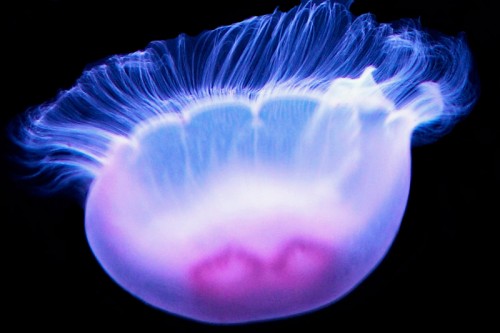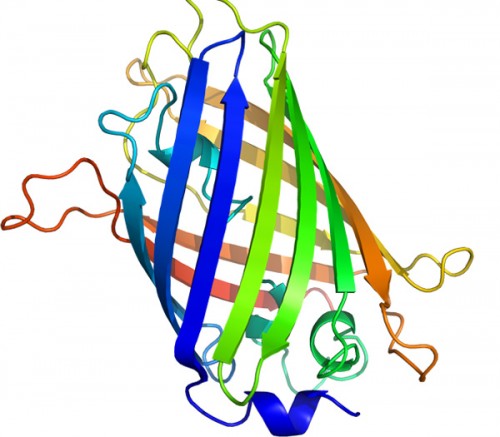Swedish Researchers Use Dripping Jellyfish Goo to Create New Solar Cells
Life is funny sometimes. Just yesterday I was talking to a coworker about this crazy book I’m reading that I may have mentioned in a previous post called The Singularity is Near by Ray Kurzweil, in which the author posits that we are moving towards a world where our technology and biology fuse to become indistinguishable, and now today I’m writing about solar cells powered by bioluminescent jellyfish. Let me also say that I’d much rather write about jellyfish than swim with them; they navigate the sea in creepy pulsing motions and some of them sting and some of them can kill you.
Lucky for all of us, Swedish researchers do not share my trepidation and have devised a way to make quivering, gelatinous, bioluminescent jellyfish into electricity. The specific jelly they used is called Aequorea victoria, and it was chosen because the organism produces a green fluorescent protein (GFP) that, when dripped onto a silicon dioxide substrate between two electrodes, works itself into strands to create a circuit that absorbs photons and emits electrons in the presence of ultraviolet light. The electron current (aka electricity) can then be used to power your hairdryer or whatever.
Image courtesy Inhabitat
The jellyfish solar cells function similar to dye-sensitized solar cells, but don’t require titanium dioxide (Scott). GFP “doesn’t require expensive additives or costly processing, but can go directly onto the substrate where it starts cranking out juice. Further, it can be integrated into a self-contained fuel cell that requires no outside light source. Photons would instead be generated within the fuel cell by enzymes like the ones found in natural light-producers, like fireflies or sea pansies. Such a power source could be miniaturized to power tiny nano-devices” (Dillow). I’m sorry – the idea of a nano-scale fuel cell powered by glowy enzymes is riotously cool.
Image courtesy Inhabitat
I will point out that jellyfish were harmed in the production of the solar cell, but it should also be noted that the world’s oceans are currently chock full of jellyfish. They apparently thrive on toxic and acidified ocean water (see Gulf Oil Disaster). In fact I was dismayed to learn that right now as I type there are massive jellyfish swarms roaming the high seas like so many hordes of wasps. That simile was a bit tortured but you know what I mean. Perhaps harvesting pollution-produced jellyfish from the ocean and using them to make electricity without burning fossil fuel could be a good thing? What do you think?
The jellyfish goo is being filed under water for obvious reasons and fire because of the glowing/electricity angle. Cited:
Dillow, Clay. “Swedish Researchers Harness Green Goo to Create Solar Cells from Jellyfish.” Popsci 09/07/10. Accessed 09/09/10. URL.
Scott, Cameron. “Solar Cells made from Bioluminescent Jellyfish.” Inhabitat 09/08/10. Accessed 09/09/10. URL.

















Hey…God had this figured out a long, long time ago…if you so choose to believe in him (which I do BTW). Sometimes you’ve gotta go backwards to go forward. Poor jellyfishes. Awww.
First GFP revolutionizes Molecular Biology, now it has its sights set on Renewable Energy? Sweet!
Of course, you can already use bacteria/yeast/immortalized cells to make metric boatloads of GFP… Though I can see the appeal of the purification-less “drip it and forget it!” method!
@Rob – How is GFP being used in Molecular Biology?
Well, it was at least good enough to warrant the 2008 Nobel Prize in Chemistry!
It’s comparable to the difference between still photography and video. At the time, almost any time you wanted to take a picture of anything specific inside a cell, you had to “fix” the cell at that position in time, and then get your labeling agents into the now dead cell in order to get an image of that one point in time for that one cell.
By adding GFP to the end of any protein you were interested, you suddenly had the ability to track almost any protein, in real time! The same cell, only with infinite timepoints now. Tweak GFP so it emits red light, and attach it to another protein of interest and NOW you can see if protein A interacts with protein B both spatially AND temporally.
And that’s just the start.
Leave a Wordpress Comment:
Ads
Watch ARCHITERIALS Videos on vimeo
Like on Facebook
Twitter
Flickr
Hit Counter
Ads
Blogs
Green
Journals/Publications
Materials
Network/News
Offices/People
Resources
Science
Pages
Archive
RSS and Email Subscriptions
Tag Cloud
3D 3D printer AB FAB academic acid acrylic actuated matter adaptive adhesive adsorption aerogel air air conditioning alloy aluminum amnh antibacterial antifungal ants april fool's architecture architecture robot artificial skin autonomous aviation awesome bacteria bamboo bananas beer bench bend bending biennale biocomputing biodegradable biodegradeable biomaterials biomimetics biomimicry biominerals biopolymer birds blast blast-resistant block blocks blogs Bloom Box brazil brick bubbles bucky bulk metallic glass butterfly calera canvas carbon carbon fiber carbon nanotubes carpet cars ceiling cellulose cement ceramic chain link chair charcoal charlie sheen chemicals chiller clay cloth cloud cmu coils color color-changing communication compound computer concrete condensation conducting conductive context cool coral cracks crystal cyborg demakersvan design digifab dirt disaster dna dror drywall dutch dynamic EAP earth ecocradle ecolect e coli ecology ecoresin ecovative elastic electric electricity electrochromic electroluminescent electronic energy energy recovery environment evaporative cooling experiment fabric fabrication facade fiber fiberglass fiber optic fiber optics fibers film FIRE flexible flickr fly ash foam fungus furniture garbage gel geodesic dome geometry gfrp gilgamesh glass glass fiber glow glue gold graphene green greensulate gsapp gypsum hard heat heavy heidi klum helix hemp hexagon hidden high performance hive honeybee humidity ice India ink insulation interference Internet inventables invisible invisible ink jello jellyfish just add water kevlar kinetic korea lace lamboo laser lattice leaves LED leed LEGO light light emitting light transmitting liquid lo mein london Loop.pH machines magic magnetic marine material materials meatball melting memory metabolic engineering METAL metal panel metamaterial micro microsensor microtools military milk MIT moisture multi-layer mushrooms mycelium nano nanogel nanotech nanotubes NASA new noise non-metallic oil OLED OMA ostrich oysters packaging paint panel panels paper paperfoam paraffin wax particles particulates petroleum phase change phosphorescent pink PLA plastic platinum pm-10 poetry pollution polymer polymers porcelain power precast printed printing protein public quadror radiant rain rammed earth reclaimed recycled reflective refracting Rem Koolhaas resin robot robotics roof rubber rugged sand sealant sealer search segmented self-healing sensor shape memory silica silicon silk skin skittles slats smog soft solar solar cell solar cells solar paint solid solid state lighting sound spider spider glue spray stabilized sand stone stretch stretchable strong structural structure studio dror sun sunglasses super supercritical sustainable switzerland tags tape technology TED tensile TEXAS textile textiles texture thermal thermochromatic thin thin film thread tiger stone tile tiles timber tio2 tires toaster tokujin yoshioka touch touch-sensitive toxic transparent t shirts tulip ultra-thin university of akron university of connecticut upcycling virus voc wall wallpaper WATER web wet whale wires WOOD woodwool wool workshop
WP Cumulus Flash tag cloud by Roy Tanck and Luke Morton requires Flash Player 9 or better.
Recent Comments
Ads
Recent Posts
Most Commented
Most Viewed